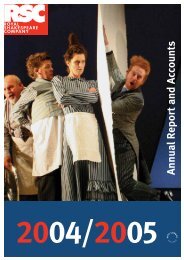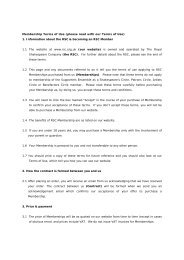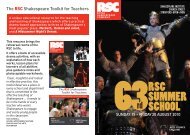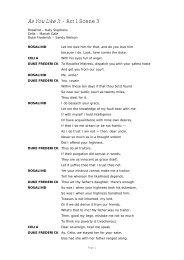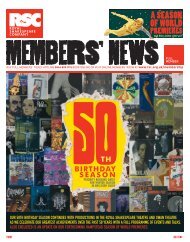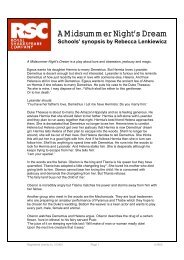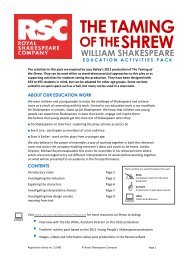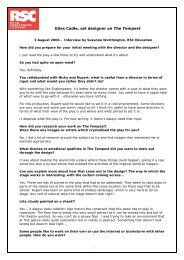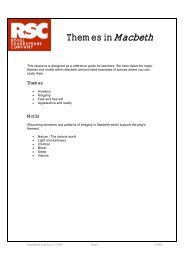SPOTLIGHT ON COSTUME - Royal Shakespeare Company
SPOTLIGHT ON COSTUME - Royal Shakespeare Company
SPOTLIGHT ON COSTUME - Royal Shakespeare Company
Create successful ePaper yourself
Turn your PDF publications into a flip-book with our unique Google optimized e-Paper software.
Spotlight on<br />
Costume<br />
Information Sheet<br />
The 28 workers in the RSC Costume<br />
workshops demonstrate a diverse range<br />
of specialist skills. These include not only<br />
tailoring and costume making but dyeing,<br />
printing, leatherwork, beading, corsetry,<br />
millinery, mask-making and jewellerymaking<br />
to name but a few.<br />
The complex of buildings opposite the<br />
main theatre building in Stratford includes<br />
workrooms devoted to Men's Costume,<br />
Ladies' Costume and Hats & Jewellery,<br />
as well as an Armoury and a Dye Shop.<br />
From designing to fitting<br />
Costume design is a complex and<br />
time-consuming process. Often the<br />
workshops have only a few weeks to make<br />
a complete set of costumes. The journey<br />
begins when the costume designer meets<br />
Alistair McArthur, Head of Costume.<br />
“We talk through the general requirements<br />
of the design with regard to period,” Alistair<br />
explains. “Then we discuss the budget and<br />
costings. The designer is allocated a Costume<br />
Supervisor who will be their right-hand<br />
person through the design and construction<br />
process. The Supervisor is responsible for<br />
ensuring that the two-dimensional drawings<br />
become a three-dimensional reality.”<br />
Designers and Supervisors involve the<br />
actors as much as possible in the design<br />
process. To ensure that the costume suits the<br />
particular actor many designers wait until<br />
the production is fully cast before completing<br />
their designs. At the start of each season<br />
all the acting company are measured. Over<br />
fifty measurements are taken from each<br />
actor. Any allergies are noted and taken into<br />
consideration.<br />
Next, the Designer and Costume Supervisor<br />
begin to sample and purchase fabrics,<br />
visiting shops in London as well as consulting<br />
a large pattern room in Stratford where<br />
fabric samples are kept from both national<br />
and international suppliers. If the designer<br />
requires a particular colour or pattern,<br />
fabric can be dyed or printed by the RSC’s<br />
Dye Department. As soon as fabrics start<br />
to arrive they are handed to the cutters<br />
in the workrooms. The RSC cutters draft<br />
all patterns themselves according to the<br />
specifics of each design. Once the fabric<br />
pieces are cut they are handed on to a team<br />
of makers who start the construction in time<br />
for the first costume fittings.<br />
At the first fitting with an actor, which lasts<br />
around half an hour, the designer decides on<br />
the visual look of the garment, the length of<br />
the hem, style of trim etc., while the cutters<br />
concentrate on the basic fit and technical<br />
aspects of the costume. The Costume<br />
Department tries to avoid using zips in their<br />
costumes. “If someone is doing a quick<br />
change during a show we can’t risk a zip<br />
getting stuck,” Alistair explains. For quick<br />
changes we try not to use Velcro as it ruins<br />
the line of the fabric and is very noisy. We<br />
now use industrial strength magnets which<br />
work really well. Sometimes designs change<br />
considerably through the making process.<br />
There has to be a lot of co-operation between<br />
the designer, our team of makers and the<br />
actor to ensure actors get costumes they like<br />
and feel comfortable with.<br />
Ready for the stage<br />
Before any costume or pair of shoes or boots<br />
goes on stage they may be ‘broken down’<br />
by the Dye Department. Breaking down is a<br />
process of distressing a costume to give it a<br />
worn and authentic look. Jacket sleeves are<br />
tied up with string, sprayed with water and left<br />
overnight to get authentic creases. Pockets<br />
are made to sag realistically by filling with<br />
paper or stones. Costumes can be rubbed<br />
with sandpaper or soap to make the garment<br />
look worn or greasy. The Dye Department<br />
also regularly covers boots and shoes with<br />
specially made ‘mud’.<br />
The RSC has an onsite Armoury where Julian<br />
Gilbert and his team produce breastplates,<br />
gauntlets, belts and weaponry as well<br />
as overseeing all the footwear for each<br />
production. Specially designed swords are<br />
made without an edge, and their lightweight<br />
construction makes them easier for actors to<br />
work with.<br />
The Costume Supervisor compiles the<br />
Costume Description List. This is a document<br />
that details every individual item of costume<br />
worn by the actor in each scene. This is<br />
given to the Running Wardrobe team so that<br />
they know what each actor is supposed to<br />
be wearing. To aid this, every single item of<br />
costume from hats to socks is labelled with<br />
the name of the production, character and<br />
actor’s name.<br />
The technical rehearsal is the first time that<br />
the actor gets to wear the complete costume<br />
and the first time that the designer sees the<br />
costume under stage lighting. This is a very<br />
busy time for the Costume Department. Some<br />
costumes may need alterations in terms of<br />
design or fit, some need extra work in the Dye<br />
Shop and sometimes unforeseen difficulties<br />
arise as part of the technical process.
Getting it right, every night<br />
Once the production is up and running all the<br />
costumes have to be maintained on a daily<br />
basis. “Maintenance of costumes is often<br />
looked upon as a bit of washing, drying and<br />
ironing,” Alistair explains, “but it’s much<br />
more than this. Certain fabrics are very<br />
delicate and have to be cared for with very<br />
special knowledge. All the shirts, tights,<br />
socks and other linens have to be washed<br />
after each performance. There is a constant<br />
list of running repairs. It’s a big job and great<br />
care must be taken. Elaborate costumes are<br />
dry cleaned as necessary. Most costumes<br />
aren’t washable so we use inner costumes or<br />
‘shields’ that can be removed and washed.”<br />
“For example in the 2004 production of House<br />
of Desires most of the men wore leather<br />
‘catsuits’. Leather and suede cannot be<br />
washed or dry-cleaned so each actor wore a<br />
lycra body stocking underneath to absorb the<br />
sweat and which could be washed. In fact, due<br />
to the high energy levels in the show, each<br />
actor had 2 leather costumes plus 2 washable<br />
bodies that they could change into at the<br />
interval. We always have to think ahead as to<br />
how we can maintain the costumes.”<br />
Everything the Costume Department makes<br />
is created to last. “People sometimes imagine<br />
theatre costumes are held tight with bulldog<br />
clips,” McArthur laughs, “but nothing could be<br />
further from the truth. Whereas an everyday<br />
shop-bought suit might be worn a few dozen<br />
times, an RSC costume will be on stage for<br />
well over 100 performances and so must be<br />
made to much higher standards to live up to<br />
the rigours of the stage.”<br />
Costume curios:<br />
Life in the Costume Department<br />
• During an average year, the Dye Department<br />
goes through 60 kilos of dye powder, 800 kilos of<br />
salt and 1500 pairs of disposable gloves.<br />
• For The Histories Cycle, the Hats & Jewellery<br />
Workroom made 27 crowns; some out of metal<br />
and some out of plastic.<br />
• An average set of armour uses 53 sets of<br />
buckles and straps – all individually made to<br />
spec. - and approximately 350 sets of rivets.<br />
• The costumes for the complete eight plays in<br />
the Histories cycle in 2008 filled over 100<br />
four-foot-long dress rails.<br />
• As well as many UK suppliers the Costume<br />
Department also buys fabrics from Germany,<br />
Italy and France; metal for crowns from Bavaria;<br />
crystal beads from Austria; fans from Spain;<br />
specialist haberdashery from New York and is<br />
always sourcing new manufacturers.<br />
• In the 2008 production of A Midsummer Night’s<br />
Dream, Oberon’s coat was constructed from over<br />
320 individual pieces.<br />
• All RSC hats, boots and costumes make their<br />
way to the RSC Costume Hire after the end of<br />
a production and are available to be hired by<br />
schools, dramatic societies and other theatres.<br />
To find out more call 01789 205 920<br />
Career Information<br />
There are many routes into a profession<br />
within the Costume Department. All staff<br />
are trained to a high standard. Although<br />
some learn these skills on the job, most<br />
have a relevant degree-level qualification in<br />
addition to specialist professional training.<br />
Alistair McArthur, Head of Costume,<br />
originally trained as a stage manager. He<br />
has worked his way up in the costume field<br />
with positions at the <strong>Royal</strong> National Theatre<br />
and the <strong>Royal</strong> Opera House, in addition<br />
to employment as a freelance costume<br />
supervisor. “Once you leave any costumemaking<br />
course the best thing to do is to find<br />
a freelance maker who is willing to take you<br />
on as an assistant. You can only learn so<br />
much in a college and you learn much more<br />
actually doing the job.”<br />
“Anyone who wants to become a milliner<br />
has to start by really wanting to do this,<br />
as it’s a very different skill to making and<br />
sewing costumes” says Head of the RSC<br />
Hat and Jewellery Department, Elaine<br />
Moore. Elaine has a qualification in theatre<br />
design from West Sussex College with a<br />
specialism in millinery. Other members<br />
of her staff have degree qualifications in<br />
fashion and costume. Previous members<br />
of staff have trained in embroidery and 3D<br />
design. “Theatre millinery is completely<br />
different to fashion millinery because the<br />
hats have to be much stronger. Our hats<br />
might be worn every day for two years, even<br />
though they perhaps need to look like they<br />
are made out of cobwebs,” Elaine explains.<br />
“Also, just because someone is a fantastic<br />
street hatmaker does not mean they will be<br />
a good costume hatmaker. Most successful<br />
people start with an interest in theatre<br />
first. Flexibility is important as we do<br />
both delicate and big butch work. We also<br />
style and heat metal as well as work with<br />
intricate beads.”<br />
Julian Gilbert came to the RSC Boots and<br />
Armoury in 1967 when he was seventeen,<br />
now he is Head of the Armoury. “It’s hard to<br />
train for this area of work,” Julian explains.<br />
“We deal with so many types of fabrics and<br />
materials, and many different processes<br />
that it can be better if someone comes in<br />
without any preconceptions. What we are<br />
really looking for is the right attitude to<br />
the work and flexibility. There is a lot of<br />
repetition involved in our work, and it can<br />
be very demanding at times. One set of<br />
armour might have over 50 sets of buckles<br />
and straps and these can be very time<br />
consuming to make.”<br />
Work experience placements are available<br />
in RSC Costume but there is always a<br />
waiting list.<br />
A Day in the life of<br />
Running Wardrobe.<br />
The Running Wardrobe is staffed from<br />
9.00 am to 11.00 pm and the day starts<br />
with the laundry. Every item of clothing<br />
that touches the skin is washed immediately<br />
after each show, which often involves up to<br />
8 wash loads every night, and these must<br />
be dried, ironed and set into the appropriate<br />
dressing room box ready for the dressers to<br />
collect in the evening. The recent production<br />
of The Taming of the Shrew, for instance,<br />
involved some 74 shirts for each performance,<br />
as well as underwear, etc. In addition, any<br />
repairs are noted immediately after each<br />
performance and must be completed before<br />
the next show goes up. Jewellery may need<br />
to be mended, boots resoled, or stage blood<br />
cleaned from costumes. Most of these<br />
repairs will be carried out within Running<br />
Wardrobe, although some more major work<br />
may mean a costume has to be returned to<br />
other parts of the Costume Department.<br />
Costumes are then placed on divided rails<br />
ready for collection by the dressers.<br />
During the afternoon, the Wardrobe<br />
Mistress or her deputy will be hard at work<br />
preparing for the next production coming in,<br />
or for understudy technical rehearsals and<br />
runs etc. This involves labelling boxes,<br />
dressing rooms, typing up dressing notes,<br />
sorting out understudy techs and runs, so<br />
that all of this preparatory work is done<br />
before the shows arrive. Every item of<br />
costuming is labelled with the actor, role<br />
and production, and jewellery, daggers, etc.<br />
are placed in labelled boxes for each actor.<br />
The dressers arrive an hour before the show<br />
goes up and pre-set all the costumes for<br />
the performance that night. Costumes are<br />
collected and set in the dressing rooms, and<br />
wherever quick changes are needed. This<br />
may be backstage, in the auditorium, in a<br />
corridor, or even in the foyer – although<br />
foyer changes are not usually set until the<br />
show has started! Each dresser will have<br />
up to 7/8 actors in their care and it has been<br />
calculated that the four dressers will carry<br />
out up to 45,000 quick changes per year!<br />
Half an hour before the show begins the<br />
dressers will go in to the actors and start<br />
getting them ready, particularly if it is a<br />
period show. During the show they will be<br />
carrying out the costume changes that will<br />
have been set down during the tech, and<br />
which will not be altered after Press Night.<br />
It is essential that the dressers work well as<br />
a team because they may find that they are<br />
expected to be in two places at once, and<br />
colleagues will then help out by stepping<br />
into the breach. It is also essential to have<br />
great people skills, as the actors rely upon<br />
them to ensure that the show runs smoothly.<br />
They may have to do running repairs, to<br />
provide tissues, water, or anything else that<br />
may be needed. At the end of the show, the<br />
dressers also make sure that costumes are<br />
back on rails, laundry is in the basket and<br />
that the dressing rooms are tidy. The<br />
washing machines are then set to work –<br />
ready for the process to begin again the<br />
following morning.<br />
Training is generally done ‘on the job’ but<br />
dressers are usually expected to have<br />
reasonable sewing skills and a feel for<br />
fabric. They are all highly skilled, but get<br />
through the long working days with<br />
professionalism and a lot of laughter!<br />
Information Sheet<br />
<strong>Royal</strong> <strong>Shakespeare</strong> <strong>Company</strong><br />
Stratford-upon-Avon<br />
TICKET HOTLINE<br />
0870 609 1110<br />
book onLINE<br />
www.rsc.org.uk



